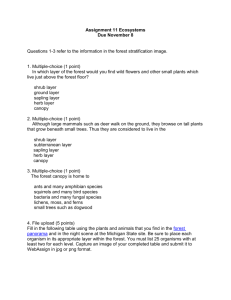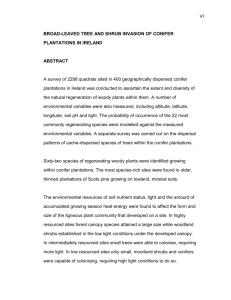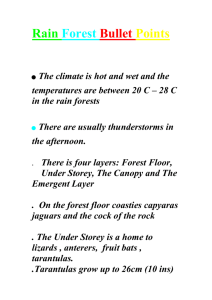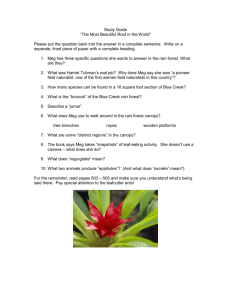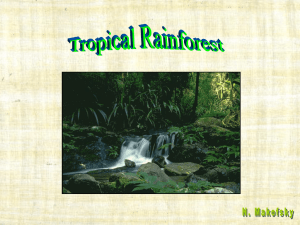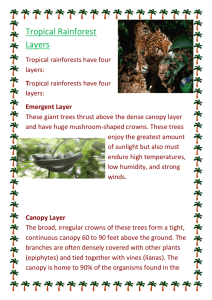Production Forecast & The National Forest Inventory Ben Ditchburn
advertisement
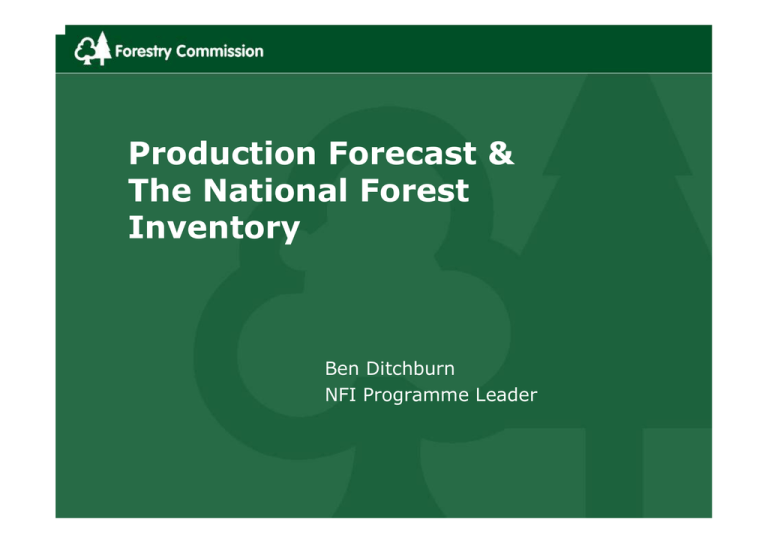
Production Forecast & The National Forest Inventory Ben Ditchburn NFI Programme Leader High Level Reporting Aims ‘State of The Nations’ Forests’ •Woodland and Forest Area •Forest Type •Forest Habitat •Forest Habitat Condition •Forest Management •Forest Use •Carbon Sequestration •Timber Production Forecasting •Wood fuel potential National and International Reporting, e.g UN - FAO, MCPFE, LULUCF 2 27/11/2009 NFI Outputs 3 27/11/2009 Key Issues to Resolve •How do you measure a forest? •What are you interested in within that forest? •What do you need to measure within that forest to monitor those areas of interest? •How far wrong in the answers can you afford to be? +/- 1% ? +/- 2% ? +/- 5 % ? +/- 10% ? +/- 50 % ? +/- 200% ? •Establish the level of sampling required to achieve the above 4 27/11/2009 Basic Components of a NFI MAP The map gives us: •Area •Interpreted Forest Types •Interpreted Open areas •In the future, it will give us changes in these, by comparing successive maps. This constitutes a near census of the whole population, which is very accurate. FC can achieve this by making use of Remote Sensing. FC will currently use Aerial Photography, but will also use other forms of RS, as they become utilisable. FIELD SAMPLING We need to know more than just area and the IFT and have to go a step further to find out more detailed information about the forests. We achieve this through sending surveyors out into the field to observe and measure a proportion of the forests. This will tell us things like: •Species •Age •Top height •Dbh •Habitat, etc The field measurements and the proportion of the samples that they represent are then multiplied by the total forest area from the map, to give a total estimate of that reporting requirement 5 27/11/2009 Core Elements to Manage •Cost. What can we afford? (What do stakeholders require, what do we require as a business require, what must we do legally?) •Timing. How quickly and often do we need answers? •Quality. A combination of requirements and accuracy 6 27/11/2009 Wood - A renewable resource 7 27/11/2009 Stages in Deriving a PF 8 27/11/2009 9 27/11/2009 Error Budgeting 1 0 27/11/2009 Error Budgeting 9. +/5.7% 1 27/11/2009 Consequences on the PF of estimating fell year incorrectly - Current Assumptions 1 2 27/11/2009 Consequences on the PF of estimating fell year incorrectly - Current PS Practice 1 3 27/11/2009 Separating what we can predict confidently from what we cannot in the PF 1 27/11/2009 PF 2011 Outputs •Total Current Standing Volume, very accurate •Conifer Volume Forecast for 10 yr. - Biological potential: •GB - +/- 2% •Country +/- 4% •Region average of +/- 8%* (*this will go up or down with area of conifer (more conifer gets better results, less conifer results decline)) •Conifer Volume Forecast - 10 to 25 yr. - Biological potential: •Precision as above with some decrease over time •Stem Straightness assessments • Feeding into assortments for SS and Pine •Biomass •Carbon Sequested Beyond 2011 (2012 - 2014) As above for Blvd, same CI as conifer in 2014, four fold decrease in precision at 2012 1 27/11/2009 NFI Methodology 1 6 27/11/2009 NFI Woodland definition for Great Britain To map all woodland (both urban and rural, regardless of ownership) which is 0.5 ha or greater in size. Canopy – the land must have > 20% tree canopy cover, or potential to achieve >20%. Width – minimum width of woodland is 20m 1 27/11/2009 Mapping 1 8 27/11/2009 Forest Map - Derived from Aerial Photography 1 9 27/11/2009 Sample Squares - Random and Systematic 2 0 27/11/2009 Field Sampling • 8x8km grid • simple random sampling •plus top ups 2 27/11/2009 Field Work Required • Silvicultural Systems • Woodland Pasture • Deadwood - visual • Forest Type • Invasive Species • Original Ground Preparation • Recent Treatment • Management Practice • Boundary Features • Cultural Features • Micro-Habitats •Thinning • Recreation Features • NVC 2 2 27/11/2009 • General health • Ground Layer Vegetation • Field Layer Vegetation • Shrub Layer Vegetation • Mensuration Assessments •dbh •height measurements •stocking •species •straightness •live / dead • Natural Regeneration • Veteran Trees Sample Square - Divided Into Sections 2 3 27/11/2009 Vertical structure 2 27/11/2009 Canopy Structure 2 27/11/2009 Canopy Types 2 6 27/11/2009 Canopy Types 2 27/11/2009 Pilot data collection • Lying Deadwood • Stumps 2 8 27/11/2009 Sampling Timelines 2 9 27/11/2009 Bulking Up the Field Data to the Map 1. Individual Sample Squares 2. Captured on Pen Tablets 3. Brought together on the National Forest Inventory Database (Forester based) 4. Sample Square details multiplied up to the NFI map area Forester Pen Tablets X Forester Pen Tablets Forester Pen Tablets 5. NFI Information Produced 1 2 3 4 Volume 3 0 27/11/2009 5 Accuracy and Precision - Increased Sampling Increases reliability of results 3 27/11/2009 Private Sector Conifer Production Forecast / Carbon /Biomass Sampling Requirements and Target CI 3 2 27/11/2009 Summary Requirements to Confidence Interval 3 3 27/11/2009 Setting Sample Square Numbers •The Systematic Grid will allow for harmonisation with European Reporting and IFM •The number of random samples will be set through the levels of precision required and the application of statistical methodology •This will also depend upon the confidence intervals and accuracy’s acceptable at GB, Country and Region for each requirement. •The Number of Regions chosen will also affect this 3 27/11/2009 Reporting Structures 3 27/11/2009 Reporting Boundaries England and Wales 3 6 27/11/2009 Reporting Boundaries - Scotland 50% less samples in the mill catchment means a 4 fold reduction in precision +/- 8% to +/- 32% The standard number of FC PS conifer plots of circa 150 to 200 (for 2011 (circa 300 for 2014)) in the NE region available to run a PF, would effectively be halved in this scenario to 75 to 100 working for the mill forecast. A top up of 100 (at a cost of £12500) plots would rectify this . Further topping up would create additional accuracy 3 27/11/2009 3 8 27/11/2009 TOP UP Process • • • • Customer formulates business requirements Customer and IFOS work through and refine requirements IFOS evaluate what will be delivered of the requirements from the core NFI work as is IFOS present options with costs for meeting the extra customer requirements: • • • • • • • • • Providing more focussed forecasts and reports on smaller geographic areas (e.g a specific mill catchment) Improving CI in a region (e.g. plus or minus 8% to plus or minus 2%) Adding to content (e.g including timber density, rot, branching etc) Bringing forward delivery dates (e.g 2011 to 2010, 2015 to 2103) Additional analysis or forecast scenarios ( different products etc) Content, timelines, delivery date and cost agreed Contract entered into guaranteeing FCs minimum delivery of ‘match’ squares Customer funded squares put in on ground, plus FC’s if not already in place Data analysis and forecasting undertaken and final report produced 3 9 27/11/2009 Conclusions •Methodology and approach is sound •Clear Link between what is measured, spent on measurement and confidence in outputs established •Effective use of new technologies (AP, GIS, RS) •Evidence base for timber, carbon and biomass accounting and forecasting established •Permanent sample squares will allow for increased capacity in change detection •Reporting boundaries allow for working with less money,shorter reporting cycles and new political structures •Defined target snapshot dates •5 year cycle •Rolling programme, not boom and bust •Top up capacity will allow for regional, industry (mill) and country stakeholder specific requirements to be met (e.g SWE and Y & H top ups) 4 0 27/11/2009 Questions & End Questions Contact ben.ditchburn@forestry.gsi.gov.uk 4 27/11/2009 NFI and NIWT 1 Key Elements Method Map Number of Sample Squares (sample fraction) Survey design Clustered and stratified Sample Square type Size of sample squares Number of or time taken to measure a sample square Temporary I Hectare 1.5 a day (range 1 to 9 per day) Period over which taken Reporting cycle 5 years 4 - 19 years, 19 – 27 years for NIWT1 (1924,1938,1947,1951,19 65,1980, 1999 (not all were full surveys)) GB, Country, Region, County Reporting levels Funding for plotting 780K per annum Error budgeting employed to design the programme No (flat 1% sample employed in 1999, but some was employed in 1980) None Use of private sector data for aiding inventory Use of private sector data for aiding building a management intent picture Top up option available to improve accuracy Small woods Survey 4 2 27/11/2009 NIWT 1 Created once every 15 years from AP then left as a snapshot in time. In the last map some AP was up to 17 years old, due to lack of availability. A second version of the map was update to 2002. 35,000- a 1% sample, with a second pass moving squares NFI Created once and then continually updated using new AP and G & L data. No AP data older than 3 to 6 years. The FE Forester map will be used to improve precision. Target 20000 to 15000, set by funding limits and the use of working backwards from desired outputs Random, with a small element on a systematic grid Permanent 1Hectare Estimated 1.5 per day (but more data taken at each square) 5 years 5 yearly, with one or two interim reports for the samples and an annual or biennial map based, area report GB, Country , Region for sample data, down to county for the map (areas) 540 yr. one, 440k per annum Yes Partial None Partial / significant No Yes Yes Yes NFI and NIWT 1 Key Outputs Outputs /data taken Forest type Forest area Forest Area Change Stand structure Shrub layer Deadwood Field layer Regeneration Broad and priority habitat type Condition No – but some measures have been derived Woodland edge NVC Recreation Not Not taken Taken as part of mgt practice Yes Not taken None Management practice Archaeology Mensuration, biomass and co2 sequestration data taken (dbh, top height, stocking density, stem form) 4 3 27/11/2009 Taken Yes (based on old AP) Survey areas compared but unable to monitor real change in woodland area between surveys Taken Taken Taken for fallen only, standing (qualitative), not for stumps (qualitative and quantitative) Yes Yes (broad assessment, not species specific or quantitative) Was not taken, but could be calculated to a level (about 80% could be classified) Soil Timber Quality No No Damage Invasive species Yes (abiotic and biotic) No (maybe a bit as shrubs) Taken Yes Yes, including real change and causes Taken Taken Taken for standing, stumps and lying (quantitative) Yes Yes Taken, most of basic data is collected , but there is some debate over whether this can define beyond 80% of Priority HAP types (re soils and NVC) Yes , probably, based on expert advice, but as no definitive condition protocol in place, this cannot be absolutely guaranteed Proposed Taken Taken Yes Not taken Two 0.01Ha mensurational plots per section (with an average of 2 sections per sample square this equates to four 0.01ha plots per sample square) No? Yes, stem straightness and timber density Yes Yes Diversity of woodland structure Tree and shrub composition Quality indicator 4 27/11/2009 Biodiversity Attributes Required NFI data - all at section level We need % cover of all species in all sections and all layers of canopy, Woodland Area by Priority Habitat happy to just note presence if less than say 5% canopy cover. (Decision key (identified at the section level) needed using key tree species, and NVC) NVC Woodland loss: Number of vertical storeys Regeneration potential UKNWHAP Groups Woodland Condition Requirements Woodland Area Theme (in line with Common Standards Monitoring) Cover of shrub layer Index of horizontal diversity Young Growth Old Growth In native sections (defined by species mix): NVC using NWSS method Needs adaptation for England/Wales Ensure plots that become unwooded are revisited (unless lost to concrete). On return to plot and no longer wooded: 1) Reason? 2) Current species cover (I.e. ground/field layer) or road /hardcore/ concrete etc No storyes (in canopy, shrub, regen layers) in each section % cover of each species and total % cover in shrub layer (2-5m) all sections. Tree and shrub species. Most important where a canopy exists. Sections from the map only. No additional field survey Planting year or 'established regen % cover' plus shrub layer % cover' in each section Planting year in each section Volume of Deadwood Mensuration plot: DBH dead standing trees, and DBH along transect for fallen trees. All sections: quick deadwood method - AND method to infer volume/ha for all sections/square to be agreed Woodland edge Where there is an edge to a permanent open areas, either internal or external, 1) whether it is sharp, or graded (see FC bulletin on ride management), 2) broad woodland habitat and the 3) broad open habitat. Further discussion required Open areas Broad Habitat type of open sections (those without potential to achieve canopy 20% cover) Regeneration present where expected For both height classes of regen in all sections: % cover of natural regen. Nativeness of regeneration For both height classes of regen in all sections: % cover of each species of natural and planted regen. Naturalness of regen and canopy In all sections: Naturalness of regeneration (nat/planted) and naturalness of canopy (consider NWSS method) Level of Browsing In all sections: Browsing AND Bark stripping: severity/frequency of canopy, shrub layer trees and regeneration No of tree & shrub species per section Record all tree & shrub species in all sections (both native and non-native) Canopy cover In all sections: canopy cover. % cover of all species in all sections (and count/presence below 5-10% Canopy share of native/ non-native threshold). Needs to distinguish canopy (1,2,n), shrub and ER layers and record species composition of each Presence of veteran trees In all sections: speies/DBH for each veteran Please keep pollarding y/n also.. Presence of invasive non-native species In all sections: % cover of each invasive species on list, (plus 'other' for specific invasive species of concern which may arise over time). Threats and damages Assess Area of section affected by key threats: e.g. dumping, soil exposed, enrichment indicators, pheasant damage, dying or defoliated trees.(See NWSS list) NFI Principles 4 27/11/2009


